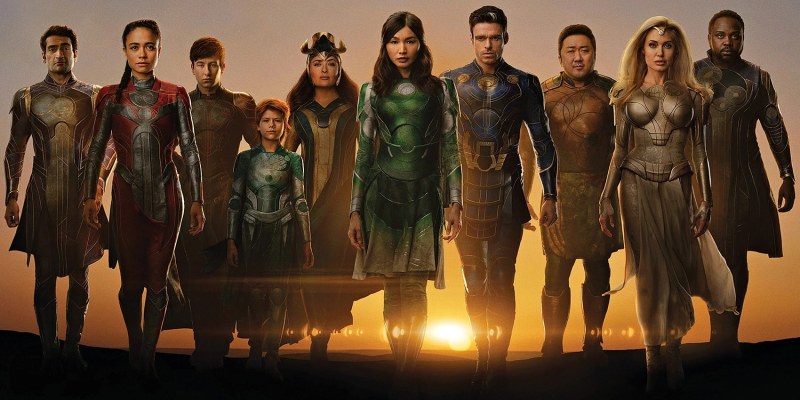Eternals in the hands of director Chloé Zhao has become something of a flashpoint in terms of the authorship debate within the Marvel Cinematic Universe.
Chloé Zhao is one of the most promising directors working in contemporary Hollywood, having recently won the Best Director Oscar for her work on Nomadland. It would seem obvious that Zhao is a director to watch and that any studio collaborating with her would be well advised to extend the sort of creative freedom enjoyed by auteurs like Christopher Nolan, Denis Villeneuve, or Ridley Scott.
As such, it is interesting that so much of the narrative around Eternals has come to focus on how much control she enjoyed over the finished film. In a recent interview with IndieWire, Zhao had to assure the interviewer that she had directed the action and special effects in the film. “My God, for a year and a half, three times a week for a couple hours a day, I was sitting in front of a big screen making decisions for every detail of how visual effects could look in the real world,” she explained.
Even earlier coverage of the film’s production emphasized Zhao’s active control over the project. Profiles following her Oscar win reported that Zhao “was really fighting for practical locations” to be used, with producer Kevin Feige arguing her case to senior management. From the outside, this looks like it might simply be pervasive sexism directed at an emerging female director, with the press assuming that Zhao is not enjoying the freedom afforded to male contemporaries.
However, there is a lot of context at play here. There are reasons why Chloé Zhao has had to aggressively assert her own authorship of Eternals. She is very much fighting against the perceived corporate culture at Disney in general and at Marvel Studios in particular: an environment that has been documented as being somewhat hostile and antagonistic to directors with the kind of strong and distinctive vision associated with award-winning talent like Zhao.

In particular, Zhao’s insistence that she directed the movie’s action exists in the context of a very specific quote from Argentine film director Lucrecia Martel, who declined the invitation to direct Black Widow when she was told that she would not be directing the action. “They also told me, ‘Don’t worry about the action scenes, we will take care of that,’” Martel recalled in 2018. “I was thinking, well I would love to meet Scarlett Johansson but also I would love to make the action sequences.”
There is nothing wrong with a director delegating action direction to a second unit. Steven Spielberg was only able to make Raiders of the Lost Ark as efficiently as he did because he delegated to Mickey Moore — he even joked that a visiting George Lucas became his “second unit.” Many directors even have their own trusted assistant and second unit directors. However, there are other directors who prefer to avoid using second units.
“If I don’t need to be directing the shots that go in the movie, why do I need to be there at all?” asked Christopher Nolan, who sees second units as “a very expensive luxury.” Director Denis Villeneuve and cinematographer Roger Deakins insisted on shooting Blade Runner 2049 with a single unit, when the studio wanted nine. There is nothing wrong with a director using a second unit, but there is something disconcerting in a studio forcing a director to give up that control.
To illustrate how this approach to filmmaking can impact the idea of authorship, it’s worth considering a particular example from Marvel Studios. Joe and Anthony Russo directed Captain America: Civil War. However, it’s notable that one of the movie’s signature action shots recurs in David Leitch’s Fast & Furious Presents: Hobbs & Shaw. Leitch had served as second unit director on Civil War, which may explain why that connection exists. Is it a Russo Brothers shot?

Marvel has a history of beginning pre-visualization of scenes and special effects “before the cinematographer or director has signed on to the project,” effectively limiting the influence that these creatives can have on the finished project. Production of the Marvel Cinematic Universe is often likened to a blockbuster television series, so it makes sense that the directors are often characterized similar to classic television directors: workers who manage day-to-day production.
Martel’s story does not exist in a vacuum. Patty Jenkins walked away from Thor: The Dark World when the company rejected her pitch for a cosmic Romeo and Juliet, leading to a situation where she felt that she could “not make a good movie” out of the premise that they wanted. Edgar Wright was forced to walk away from Ant-Man, explaining, “I wanted to make a Marvel movie but I don’t think they really wanted to make an Edgar Wright movie.”
Ava DuVernay turned down the opportunity to direct Black Panther because she “just didn’t see eye to eye” with Marvel Studios and decided it was better to opt out of working with the company rather than make the compromises that it would expect. Marvel Studios increasingly has a house style that limits the ability of directors to really shake up the company’s output, and so the franchise has a reliable formula that it has built up over more than a decade in production.
There are two obvious qualifications here. First, Marvel Studios is not the only studio pushing back against auteurs. In 2017, Warner Bros. reportedly committed to “avoid auteur directors who want final cut,” a philosophy epitomized by that year’s release of Justice League. More recently, the studio’s creative direction has alienated some creatives who have taken to nicknaming it “Former Bros.” That said, the studio seems eager to maintain relations with talents like David Chase and Villeneuve.

The other qualification is that Marvel Studios has worked with auteurs. Many of the best films in the franchise come from directors afforded genuine creative freedom: Shane Black on Iron Man 3, James Gunn on Guardians of the Galaxy and Guardians of the Galaxy Vol. 2, Taika Waititi on Thor: Ragnarok, and Ryan Coogler on Black Panther. Indeed, Gunn enjoyed the freedom of not using a second unit on Guardians of the Galaxy Vol. 2.
However, these directors are the exception rather than the rule. Chloé Zhao’s work on Eternals has become a flashpoint because the most recent of these “auteur” movies was released more than three and a half years ago, and the expansion of the Marvel Cinematic Universe has only accelerated since. There have been seven films between Black Panther and Eternals — more than a quarter of the total franchise; regardless of individual quality, it’s hard to argue that any of them had a distinct sense of authorship.
Eternals feels like a film directed by Chloé Zhao, allowing for the limited sample size of Songs My Brothers Taught Me, The Rider, and Nomadland. There’s a stillness and beauty to Eternals that feels much closer to Zhao’s earlier work than it does to Black Widow or Shang-Chi and the Legend of the Ten Rings. Zhao is willing to allow her actors to be introspective in a way that few Marvel Studios projects permit, and her camera captures natural beauty in a way few other working directors can.
Despite its cosmic scale, and perhaps in a compelling contrast to its concept, there’s a refreshing intimacy to Zhao’s work on Eternals. The film feels surprisingly human in its visual language, acknowledging the importance of touch and connection to these characters in a way that is somewhat at odds within the largely sterile framework of the shared universe. The film is unashamedly emotional and often more human than these sorts of projects often allow.

Unfortunately, there are limits to this. Zhao doesn’t seem to push Eternals as far into her own stylistic sensibilities as Gunn or Waititi, perhaps because her own aesthetic doesn’t fit as easily with the company’s larger stylistic playbook. Moments of stillness are often undercut with silly one-liners. Moments of intimacy and warmth are often padded out with reassurances to the audience that this takes place in the same universe as Avengers: Infinity War and Avengers: Endgame.
Still, there’s no denying that Eternals benefits from Zhao’s approach. When the film degenerates into the obligatory company-mandated third act computer-generated action climax, it is the best example of such a throwdown since the end of Black Panther. Although working for another company, Gunn’s final showdown in The Suicide Squad is another recent example of a superhero movie that lands the big final action scene.
These three sequences work for the same reason. Coogler was able to tie the spectacle to raw emotion and his own skills as a filmmaker. Gunn anchored the gigantic monster fight in clear character arcs for each of the primary cast. Zhao gives the climax genuine emotional heft while also capturing an impressive sense of scale. It shouldn’t be difficult, but very few modern blockbusters are able to accomplish the simple feat of finding resonance in the big computer-generated spectacle in the third act.
Chloé Zhao’s work on Eternals demonstrates the logic of recruiting auteur directors to work on these kinds of projects, even if the company’s house style pushes back a little too heavily in places. However, Zhao’s creative freedom on Eternals should not be considered some grand accomplishment. It should be the bare minimum.
